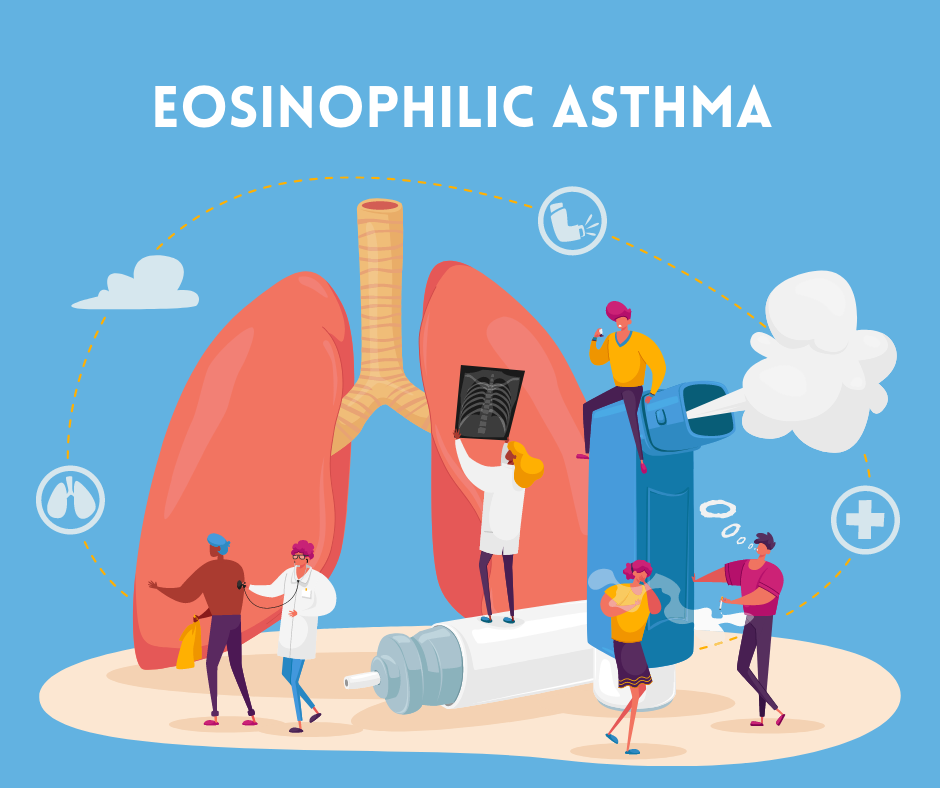There are different types of asthma. The most common type is allergic asthma where symptoms are triggered by exposure to specific allergens like dust, pet dander, pollen and mold. Another type is eosinophilic asthma, sometimes called e-asthma.
Eosinophils are a type of white blood cell that helps fight off parasitic infections and cancers. They also play a role in allergic reactions. They make up a small fraction of our white blood cells, and the number of eosinophils in our blood can vary over time. If the number of eosinophils in your bloodstream or organs is elevated, you may have an eosinophil-associated disease.
Many diseases are caused by an increased number of eosinophils in your body; one of the conditions that allergists treat is eosinophilic asthma.
What is Eosinophilic Asthma (e-asthma)?
Eosinophilic asthma is a subtype of asthma that is caused by high levels of eosinophils in the airways of the lungs. It usually starts in adulthood, although it can sometimes occur in children as well. E-asthma is a severe type of asthma and people who have high levels of eosinophils can have swelling in their airways, making it difficult to breathe.
Unfortunately, the cause of e-asthma remains unknown. However, those with e-asthma do not usually have underlying allergies that provoke asthma symptoms. Severe or uncontrolled asthma can have a significant impact on your health and quality of life. Fortunately, there are a number of ongoing clinical trials working to develop new treatments and therapies to control e-asthma symptoms.
Symptoms
Eosinophilic asthma has similar symptoms to classic asthma. However, the symptoms are more severe and constant. These include:
- Shortness of breath
- Wheezing
- Coughing
- Airflow obstruction
- Chronic rhinitis with nasal polyps
- Inflamed nasal mucous membrane
Diagnosis
If you have asthma and the symptoms are severe, your allergist may check levels of eosinophils by analyzing your blood, sputum, saliva, or conducting a bronchial biopsy (tiny forceps passed through a channel of the bronchoscope into your lungs). They will take a complete history of past and current symptoms and discuss any history of allergies.
Treatments
The goal when treating e-asthma is to reduce the eosinophils in the airways and control breathing. People with eosinophilic asthma may respond to standard guideline-based therapy which includes inhaled and/or oral corticosteroids. Others may not and need additional options. There are now new treatments that can reduce eosinophils by targeting specific cells. This type of asthma treatment is known as a biologic.
Biologic therapies that target eosinophils may be prescribed to treat eosinophilic asthma. Biologics that are currently approved for use in the U.S. include the following:
- Benralizumab: antibody that binds Interleukin-5 (IL-5) receptors. 12 years and older
- Dupilumab: Interleukin-4 (IL-4) and Interleukin-13 (IL-13) inhibitor and binds to the IL-4 alpha receptor. 6 years and older
- Mepolizumab: an antibody that recognizes and blocks Interleukin-5 (IL-5). 6 years and older
- Reslizumab: an antibody that recognizes and blocks Interleukin-5 (IL-5). 18 years and older
If you or someone you know suffers from severe or uncontrolled asthma, our board-certified providers are ready to help you find the right treatment to control your symptoms and improve your health. Call (210) 616-0882 to schedule your appointment today.
Share this entry
-
Share on Facebook
Share on Facebook
-
Share on Twitter
Share on Twitter
-
Share on WhatsApp
Share on WhatsApp
-
Share on Pinterest
Share on Pinterest
-
Share on LinkedIn
Share on LinkedIn
-
Share on Tumblr
Share on Tumblr
-
Share on Vk
Share on Vk
-
Share on Reddit
Share on Reddit
-
Share by Mail
Share by Mail



